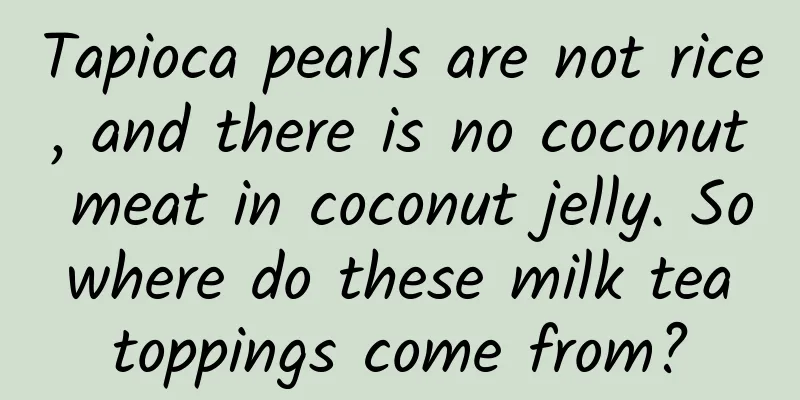Tapioca pearls are not rice, and there is no coconut meat in coconut jelly. So where do these milk tea toppings come from?

|
Review expert: Wang Xuejiang, Professor of Pathophysiology, Capital Medical University, PhD Supervisor Autumn is here, and it’s time to warm your hands with a cup of milk tea. After drinking milk tea so many times, how much do you know about the ingredients in it? The milk teas we often drink include: Yangzhi Ganlu, Coconut Milk Sago, Fruit Soup... What are the white and round "millet grains" commonly seen in these milk teas and desserts? Oh! It turns out to be sago. Pictured: Sago Sago is an edible starch made from the trunks and stems of palm trees through mechanical treatment, soaking, precipitation and drying. The most traditional sago is starch extracted from the pith of the sago palm tree and processed by hand. Sago palm and coconut belong to the palm family and are native to Southeast Asia. They look like both coconut and palm. Pictured is the Sago palm tree There is a lot of starch accumulated in the stem of the sago palm. People "scrape" the starch off, wash it, put it aside, and air it. When it is not completely dry, shake it like a Yuanxiao (Chinese rice dumplings), and it will become grains of sago, which can be added to desserts after being cooked. Tapioca is almost pure starch, containing 88% carbohydrates, 0.5% protein, a small amount of fat and trace amounts of B vitamins. However, most tapioca sold on the market is mixed with a large amount of other starch substances, such as tapioca flour. Speaking of coconut trees, is the coconut flakes in milk tea/desserts made of coconut? In fact, coconut flakes are not produced directly from coconuts, but are the product of bacterial fermentation of coconut water. Pictured: Coconut Coconut is the fruit of the coconut tree. Many of the coconuts we see for sale in supermarkets are not complete coconuts. Most of the coconuts sold in inland cities have the exocarp and part of the mesocarp removed. The outermost layer of the coconut exocarp is the smooth green thin skin, the inner highly fibrous structure of the coconut palm is the mesocarp, and the innermost bony shell is the endocarp. The seed coat of coconut is very thin and close to the endocarp. The picture shows a coconut with its outer peel still on. So when we open a coconut, we are simultaneously opening the rind and the seed inside, exposing the endosperm directly inside the seed. There are two forms of coconut endosperm. The outer layer is white solid endosperm, which is commonly known as coconut meat. Coconut shreds, coconut flakes, coconut milk, etc. are all processed from this solid endosperm. The inner cavity is filled with liquid endosperm, which is generally called "coconut water", which is the part of the coconut that can be drunk directly with a straw. This is also the raw material for making coconut nut. The method of making coconut jelly is to let Gluconacetobacter ferment in coconut water. Using the sugars and other substances in it, Gluconacetobacter can produce a polysaccharide - bacterial cellulose. These bacterial cellulose floats on the surface of coconut water, and when accumulated, it forms a thick layer of white substance. After being fished out and further processed, it becomes the coconut jelly in the dessert shop. Coconut is not only delicious, but also a good weight loss food. The main component of coconut is cellulose, which cannot be digested and absorbed by the human body, but it can enhance gastrointestinal motility and promote digestion, which has many benefits to the body. So, these small ingredients are all natural, right? But for the sake of your health, you should not eat too much. The calories in tapioca pearls are not high, but they are almost pure starch and do not contain other nutrients. They are refined carbohydrates, which increase blood sugar levels quickly and are not very filling. Among all the small ingredients, coconut flakes have the lowest calories. The main ingredients of coconut flakes are konjac and gelatin, so they are low in calories and rich in dietary fiber. However, due to the increasing demand for coconut nut, coconut juice is rarely used as a culture medium due to cost issues, and instead a prepared nutrient solution is used. As a result, coconut nut has little to do with coconut, but the name coconut nut has been retained. So, although milk tea with small ingredients is delicious, it cannot be eaten as a meal. |
<<: I heard that the "earthworm" actually "rules" the coast? In fact, its true appearance is...
>>: Which is hotter, 100℃ water or 100℃ oil?
Recommend
2017 Annual Review: Top 15 “Most Talkative” Marketing Events
Another year is coming to an end, and this year&#...
Honor Play Tablet 2 is a great tool for watching TV series without lags. It redefines the all-round entertainment tablet
There is no doubt that increasingly powerful smar...
China's new energy vehicle market has a bright future, with the support of "policy + market" to help it overtake others
Discussions about new energy vehicles have never ...
Good news: mosquitoes are dying of heat in the south; bad news: they're heading north
August 20th is World Mosquito Day . This day is n...
How to choose mooncakes for Mid-Autumn Festival? Five things to know about eating mooncakes
Key Points ★ When choosing mooncakes, check the n...
Confession of the first-class protected animal "Six-Unlike" Takin: We are cute and gentle, but...
Expert: Guo Geng, Researcher, Beijing Biodiversit...
Datong Volcano Group has a group of "volcano babies"? If you don't believe it, take a look →
The Datong Volcano Group is located in Yunzhou Di...
The benefits of Douyin Blue V certification. It turns out that it is so profitable after Douyin Blue V certification is activated!
From 2G to 3G, from 3G to 4G, and now 5G has arri...
Real Physics Terms: Microscopic Particles in Quantum Physics
When creating proper nouns, one principle is to r...
2022 New Year Experience New Tea Tender Tea Selection Reliable Arrangement Old Driver Lead the Way
Chengdu tea tasting 181-8091-4220 (V synchronous)...
In the second half of the Internet, will the traffic dividend disappear? There are 3 operating directions
In a speech this year, Xing Ge mentioned that aft...
A case study tells you the difference between a master copywriter and a novice copywriter
In August last year, I finally learned how to use...
6 steps to quickly get started with growth hacking
Growth hacking is not a new concept in China. How...
The ozone in the air made them fall in love with the wrong person
Produced by: Science Popularization China Author:...

![[Creative Cultivation Program] Why don’t you spit out the grape skins when eating grapes?](/upload/images/67f2604a8288f.webp)
![[Popular Science of Chinese Military Technology] As the "King of Rolls" among cruise missiles, what are the outstanding features of the Haiyan nuclear-powered cruise missile?](/upload/images/67f225be78d01.webp)






